Whitewater Housing Roundtable SEWRPC presenter says affordable housing likely comes through smaller lot sizes, homes
- Home
- Whitewater Housing Roundtable SEWRPC presenter says affordable housing likely comes through smaller lot sizes, homes
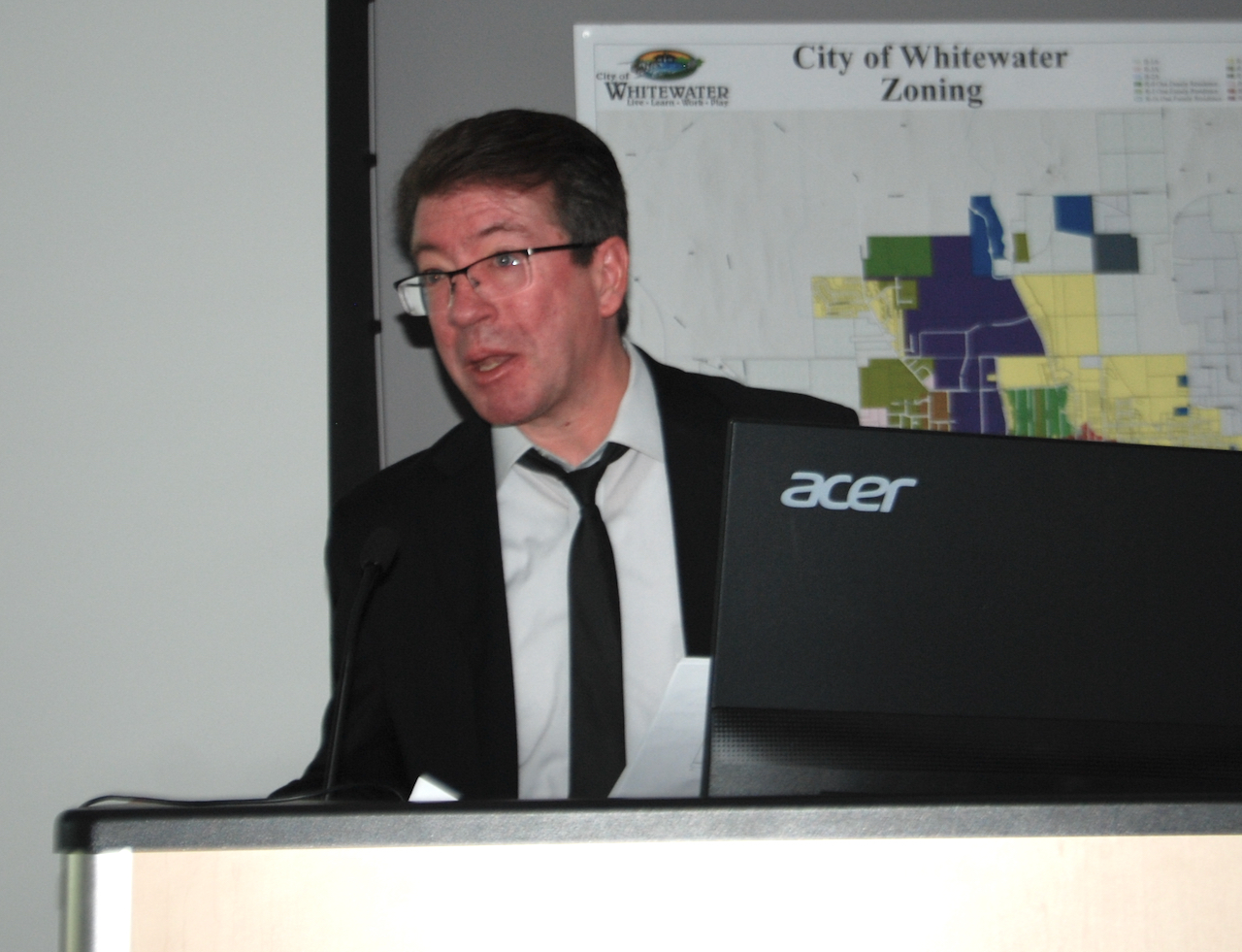
Whitewater Housing Roundtable SEWRPC presenter says affordable housing likely comes through smaller lot sizes, homes
Editor’s note: The following is the first of a two-part story regarding a Housing Roundtable presentation and discussion held last Thursday at the Whitewater University Innovation Center. The event was sponsored by city officials, including the city’s Community Development Authority. The program was presented in two parts, the first of which featured Ben McKay, the deputy director of the Southeastern Wisconsin Regional Planning Commission (SEWRPC). The second part of the program featured a housing study as presented by Erik Doersching, executive vice president and managing partner of Illinois-based Tracy Cross and Associates, Inc., a real estate marketing consulting firm. Our story will mirror the two-part delivery of the event.
By Kim McDarison
Housing inventories, their affordability, and future developments in Whitewater, and across the seven-county area which is assisted by the Southeastern Wisconsin Regional Planning Commission (SEWRPC) advisory organization, were among topics presented and discussed during a “Housing Roundtable” held last Thursday at the Whitewater University Innovation Center.
Some 60 people, all identifying themselves as having a role in housing developments — representing such groups as property owners looking to develop their land, individuals with knowledge about how to develop land, representatives of financial institutions who finance developments, members of local government, real estate agents, and landlords, among others, gathered for the two-hour program.
At the podium, delivering opening remarks, Whitewater City Manager John Weidl told those in attendance: “One of the models of management I believe in is the ‘good to great’ model by Jim Collins, who states that you need to have the right people on the bus, and you need to have them in the right seats, and I believe this is the start of that. Housing is something that is a conversation happening across the entire state, which is telling me that development and housing is becoming a market that governments are aware of and involved in.”
Weidl said he believed the “right stakeholders” were at the Innovation Center Thursday, along with members of city government, to become involved in “the housing dilemma.”
“I do believe right now we have the right people in the room to begin this conversation,” he said. He next introduced the city’s Economic Development Director Taylor Zeinert, who introduced SEWRPC’s Deputy Director Ben McKay, as one of the program’s keynote speakers.
Aided by slides, McKay began his presentation by describing the commission, and its Regional Housing Plan, adopted in 2013.
The housing plan, he said, has been used by the commission as it advises counties and communities within its seven-county region, including Ozaukee, Washington, Milwaukee, Waukesha, Racine, Kenosha and Walworth, about decisions they make regarding land use and transportation plans.
The region includes 147 cities, villages and towns, which collectively comprise 5% of the state’s land area, and 35% of the state’s population and jobs, McKay said.
He called the region an “economic engine,” of the state.
More broadly, he noted, the commission serves as an advisory group about such topics as land use and infrastructure planning to local, county and state governments.
The Regional Housing Plan, the ‘Housing for a Healthy Walworth County’ booklet, and ‘Vision 2050’
McKay said that the commission’s Regional Housing Plan offers statistics which also were used when compiling the “Housing for a Healthy Walworth County” booklet.
According to information presented within the booklet, it was produced by SEWRPC in partnership with the Walworth County Community Health Improvement Plan Committee. The 10-page document, in its introduction, notes that it was created following the launch of the Walworth County Health and Human Services Division of Public Health, which created a Community Health Assessment (CHA) and a Community Health Improvement Plan (CHIP), in August of 2021.
The CHIP worked to improve “health and wellness for all,” the document reads, and identifies housing “as one of the areas where action can be taken to improve the health of Walworth County residents.”
The booklet “presents data that demonstrates housing needs in Walworth County and community-based actions that can be taken to house a healthy Walworth County,” the introduction states.
A link to the full booklet is here: https://irp.cdn-website.com/e397a32d/files/uploaded/Housing%20for%20a%20Healthy%20Walworth%20County%20Booklet.pdf.
During the roundtable presentation, McKay said the Regional Housing Plan was adopted by the commission in 2013, however, he noted, he saw it as a “living document,” which, he said, was used to “inform” the “Vision 2050,” regional land use and transportation plan, which, according to the SEWRPC website, is a long-range planning tool developed by the commission to “shape and guide land use development and transportation improvements, including public transit, arterial streets and highways, freight, and bicycle and pedestrian facilities to the year 2050.” The plan was reviewed and updated, according to the commission’s website, this year.
A stand-alone website devoted to the plan is here: https://www.vision2050sewis.org/.
McKay said the Vision 2050 Plan was adopted by the commission in 2016, and has since been updated in 2020, and he noted, is undergoing an update.
“The next step will be adopting it in June of this year, so … that plan is still a living document even though it was adopted a number of years ago,” McKay said.
Describing the Regional Housing Plan, McKay said it includes “analyses and advisory recommendations for local governments, particularly, local governments with public sewer service. It was guided, as all of our regional plans are, by an advisory committee that was made up of 29 members. The committee included representatives from county, local and state governments and those within the home building industry, along with housing advocacy, and research and policy organizations.
“The reason for developing this plan was that our communities, even at that time, and we started work on this in about 2009 — probably right after our housing issues across the entire country — and really identified that we still had an affordable housing problem in southeastern Wisconsin.
“We needed to tackle this with a regional look at the problem, so we took that advice and request from our local governments and developed a plan,” McKay said.
A vision was created for the Regional Housing Plan, which was stated on a slide, as: “Financially sustainable housing for people of all income levels, age groups, and needs throughout the entire southeastern Wisconsin Region.”
“So the plan is all about affordable housing for people of all income levels, age groups, and needs throughout the entire southeastern Wisconsin region,” McKay noted, adding: “We are concerned about affordable housing, so generally, we wanted to know: What was the affordable housing need? And, of course, we used a generally accepted standard that a household should not pay more than 30% of its income on housing, whether it’s renters or rent insurance and utilities, and homeowners, including mortgage, taxes, etc., and even at that time, going all the way back to around 2010 statistics, there were over 280,000 households in the region spending more than 30% of their income on housing.
“And two-thirds of those,” McKay continued, “were low to moderate income households.”
A slide noted that 282,500 households or 36% of the region’s households were spending more than 30% of their income on housing.
The slide defined households of “below or median” income levels earning $53,879.
Said McKay: “So we have used that Regional Housing Plan to inform some of our work with assistance to county level governments across the region in the year since it was adopted, since 2013.”
He cited the Walworth County booklet, noting that he believed “most of the work on this particular document occurred last year, and was distributed around the county.”
McKay said SEWRPC was asked to look at housing as it relates to health in Walworth County because “housing was continually brought up as a major impacter of health for county residents, so that became one of the focuses of one of the groups that was guiding the development of this community health improvement plan. So the sections in this booklet include: Why does housing affect health? How much housing do we need? What kind of housing do we need? What kind of housing do we have? What are the housing needs of businesses? What can communities do?
“The recommendations that are included in this short booklet come directly out of the Regional Housing Plan,” he said.
McKay next delved into the answers to the questions asked in the Walworth County booklet, saying: “Walworth County first wanted to know: How much housing do we need in the short term? How much housing do we need in the longterm?”
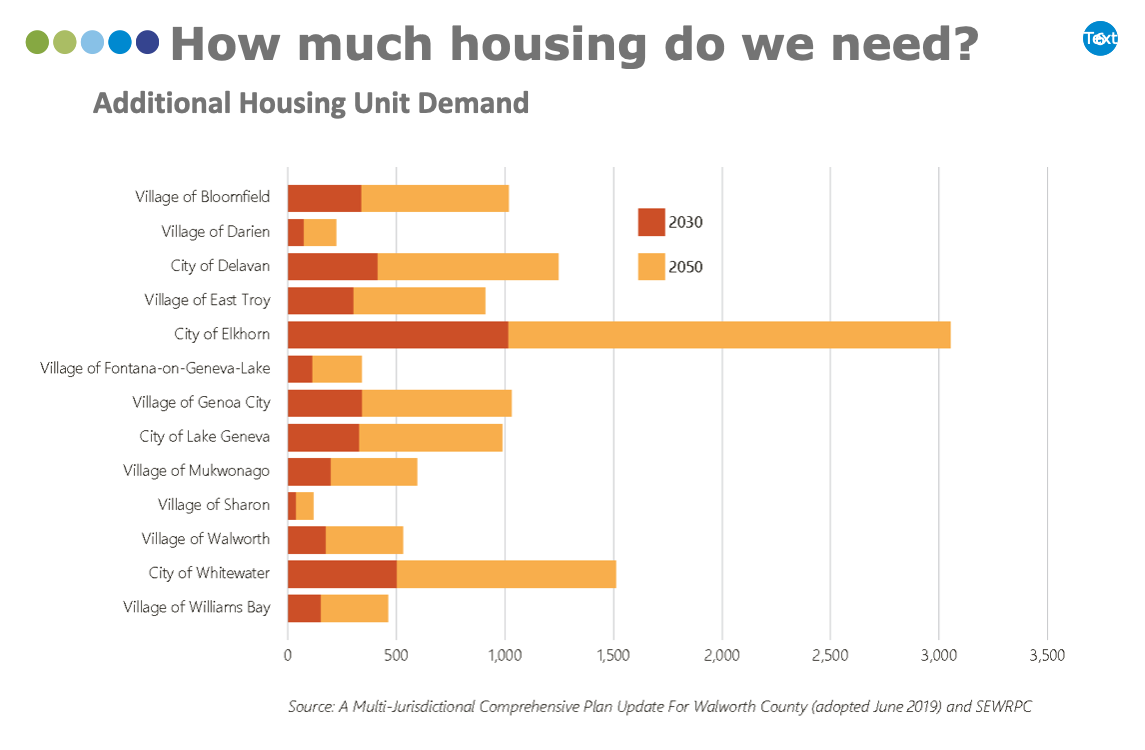
Referencing a slide, shown above, McKay said: “So we looked at projections, going out to the year 2030, as well as projections going out to the year 2050. The city of Elkhorn, based on population projections, had a great need, but the city of Whitewater, as well, looks like, by 2030, to house what would be the projected population, may need an additional 500 units, and out to the year 2050, again, based on population projections, from the Walworth County Comprehensive Plan that was adopted in 2019, and that was informed by projections developed by the commission, potentially 1,500 housing units would be needed in the city, and I think (that) matches some numbers that are seen in the city’s comprehensive plan, which puts maybe that figure at around 1,400.”
A link to Walworth County’s Comprehensive Plan is here: https://www.co.walworth.wi.us/419/Multi-Jurisdictional-Comprehensive-Plan.
A link to the city of Whitewater’s Comprehensive Plan is here: https://www.whitewater-wi.gov/462/Comprehensive-Plans-Studies.
McKay continued: “That’s a significant amount of housing … you have maybe a little under 5,500 housing units in the city (of Whitewater) right now, so that’s a lot of additional housing units compared to what you have currently.”
McKay next addressed the question: “What kind of housing do we need?” He noted: “We have a lot of statistics we can look at. I like looking at housing costs.”
He asked: “Is there affordable housing available in the community now? That might help to inform future decisions. We do have statistics regarding owner-occupied households, and I think specifically these are with a mortgage, as well as renter-occupied households, and then total households for all these sewered communities in Walworth County. We kind of stuck to the sewered communities because those are the communities that can support the higher density housing that these housing plan recommendations are really all about.”

A slide, shown above, offered a chart showing cost burdens within communities within Walworth County. According to the chart, a source for the statistics is the U.S. Bureau of the Census 2017 to 2021 American Community Survey. The chart noted that in Whitewater, there are 225 owner-occupied households or 20.6% of the city’s households, and 1,306 renter-occupied households, or 55.2% of the city’s households, for a total of 1,531 households or 44.2% that are paying over 30% of their income for housing, an amount deemed “too high,” by the standard statistic used by SEWRPC.
In Whitewater, McKay said, it was not a surprise, given the high student population.
“I think that’s driving some of these numbers,” he said.
Referencing the chart, he added: “Looking at total households, 44% of the city of Whitewater households are paying too much for housing, and again, you have a large number of renters, a large number of student population, so, I think that is driving that number a little bit, and I would say this is not all bad news per se. Walworth County as a whole is actually doing a little bit better than the region, and the state, in all of these categories, however, looking at the county as a whole, they still have 20% of households, just over 19% households that are owned, pay too much for housing, and over 40% of renters at the county level are paying too much for housing. And so there’s certainly still work to be done there even though maybe the county’s faring a little bit better than the state and region. And I believe for renters specifically the region’s a little bit higher, maybe 47%.”
A member of the audience asked if the stats would be updated.
Said McKay: “These statistics are actually a little bit more recent than the 2019 comprehensive plan. These are from the 2017 to 2021 American Community Survey, which is information put out by the Census Bureau. There is now 2018 to 2022 data available, but it wouldn’t look much different than this.”
He said the stats are calculated using a five-year rolling average.
McKay Continued: “When we developed the booklet for Walworth County this was the most recent data at the time, and the information that we are pulling from the Walworth County Comprehensive Plan is really related to population projections and household projections, so the county comprehensive plan — and that was actually an update of the original plan that was adopted in 2009 — comprehensive plans do need to be updated once every 10 years — so that was the last time Walworth County updated its comprehensive plan, and those projections are really coming from projections that SEWRPC developed for Vision 2050. The base year of that information is actually the 2010, the centennial Census, but I have more information about that looking at where those projections were going, and actually how are we doing in populations and jobs growth compared to the projections since 2010.”
Continuing with questions posed in the booklet, McKay asked: “What kind of housing do we have in Walworth County? What kind of housing do we have in the city of Whitewater? And this is not directly related necessarily to renter occupancy and owner occupancy, but it is housing structure type, so here, we are looking at multifamily housing in a broad sense.”

Citing a slide, shown above, McKay said a comparison of multifamily units to single-family units in the city of Whitewater showed 59% of units in the city of Whitewater are multifamily units and only 41% are single-family units.
McKay said renter vacancy rates within the city are between 4 and 6%, which, he said, “lies within what HUD (the U.S. Department of Housing and Urban Development) recommends.”
Looking at owner-occupied vacancy rates, he said the number is 1%, which he described as “very low.” He added: “that means that there’s a lot of demand for probably single family housing within the city of Whitewater, and potentially other types of owner-occupied housing.”
Said McKay: “I also wanted to talk a little bit about … what we are seeing in the region, and how some things, like existing regulations such as zoning and long-range planning, things like comprehensive plans, might impact the development of different types of housing within the entire southeastern Wisconsin region, (and) within Walworth County and the city of Whitewater specifically.”
In 2010, when the commission was developing the Regional Housing Plan, McKay said, the group analyzed the zoning ordinances in the region’s communities that had public sewer systems. He said that was about 90 communities. He said the commission looked for challenges associated with developing more high density, or compact, developments, which, he said, would tend to be more affordable to a wider range of households.
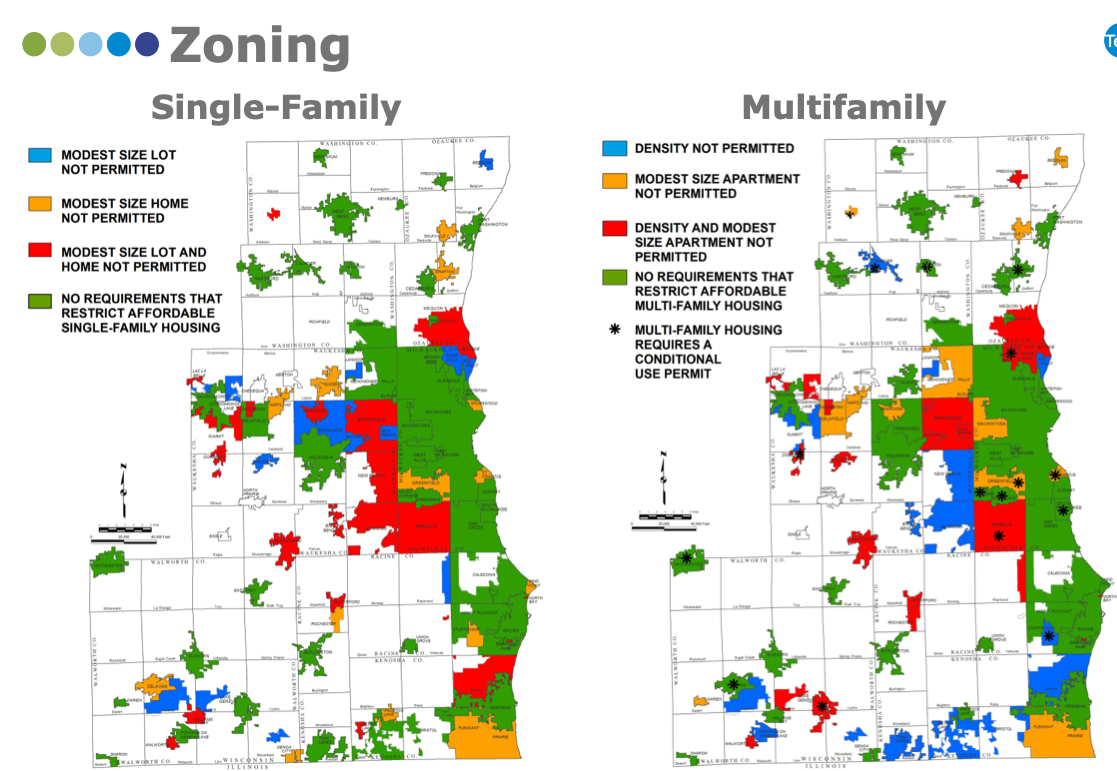
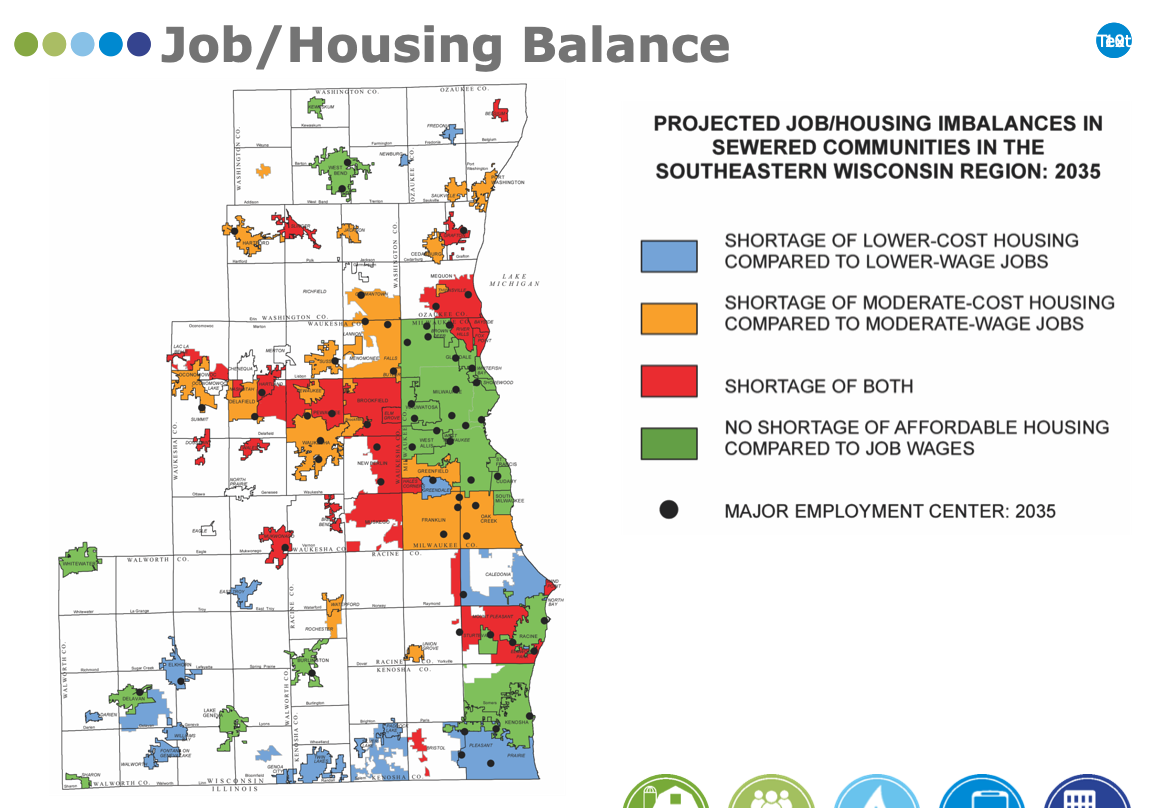
Referencing a slide, shown at top, McKay said the commission analyzed the region’s map, looking for communities with barriers to development.
“Looking at single family housing, we wanted to know are there challenges or barriers to developing smaller lot sizes? Are there barriers to developing smaller homes? And are there barriers to both? So, as we are looking at the map, under the single family map, under the modest lot size not permitted, those are the communities in blue, those communities do not have one zoning district in their ordinance that would allow a lot size of 10,000 square feet or less, and when I speak to people in the development community, I’m told a major impacter in cost is lot width, so that directly correlates to that smaller lot size, so we see a number of communities in blue are not allowing that smaller lot size in the 10,000 square feet or less,” which, he said, is about a quarter of an acre.
“What we’ve seen developed in our region in the last 10, 20, 30, even 40 years, in our sewered communities would be lots of maybe 15,000 square feet and even up to 20,000 square feet, which is about half an acre, so quite a bit less dense than what would be recommended by the Regional Housing Plan.”
Additionally, he said, the commission looked similarly at the map to see which communities would allow for the building of smaller homes, those that might be 1,200 square feet or less. The commission looked for communities that had at least one zoning district in the ordinance that would allow for the smaller construction.
Said McKay, “the communities in red are not allowing for either the smaller home size or the smaller lot size, and the communities in green do have at least one zoning district that will allow both of those smaller sizes, so the city of Whitewater’s zoning ordinance, as far as the SEWRPC analysis was concerned, was not presenting challenges to developing more modest single-family housing that might be affordable to a wider range of households.”
McKay said a similar analysis was made looking at multifamily housing, with the commission looking at communities that would allow for more density in construction, with perhaps as many as 10 to 18 units per acre. It also looked at communities with zoning ordinances that allowed for smaller apartment sizes, perhaps with 800 to 850 square feet for a two bedroom apartment.
McKay said the communities in blue are not allowing for the higher densities for multifamily constructions, the communities in orange are not allowing for the smaller apartment size, and the communities in red, are not allowing either.
Whitewater, as far as the SEWRPC analysis was concerned, is “doing well in their zoning ordinances by allowing the higher density and the modest apartment size,” he said.
Breaking down the entire region, McKay said, about 40% of the region’s communities “might have some challenges to developing more compact, higher density development that might be affordable or at least encourage affordability for a wider range of households.”
Additionally, a second slide, also shown above, offered a look within the seven-county region, at job-housing imbalances, with each color-coded section delineating communities in which shortages of low-cost and moderate-cost housing exists as compared to the number of low-wage and moderate-wage jobs in the area.
Looking ahead
McKay said the Regional Housing Plan has a design year of 2035.
Looking ahead, he said the commission wanted to know “not only what is happening on the ground now,” but what might happen regarding housing in the region in the future.
“We felt the best way to do that was to look at the comprehensive plans — this goes back to about 2010 — that were adopted by, at that time, all of the communities throughout the region that had public sewers,” which he reiterated, was about 90 communities.
McKay said the state of Wisconsin enacted a law in 1999, requiring all cities, towns, villages and counties that wanted to administer zoning ordinances to produce and adopt a comprehensive plan.
“They are very comprehensive in nature, they have nine elements. Two of the key elements that we were concerned with were the housing element and land use element, and, in particular, the land use element and the land use plan map is what informed this analysis, the job-housing balance analysis,” he said, adding that the land use plan maps included in comprehensive plans look into the future at least 20 years.
“We felt this was the best way to see a picture of what all of our sewered communities were planning on doing for housing and job growth over the next 20-year period,” he added.
Referencing the jobs-housing balance slide, McKay said communities shown in green “were at least considering enough in variety of housing types for the types of jobs they were planning for, and again,” he said, “Whitewater is coming up in green, so their comprehensive plan certainly was considering a variety of housing types, again, as far as the SEWRPC housing analysis was concerned.”
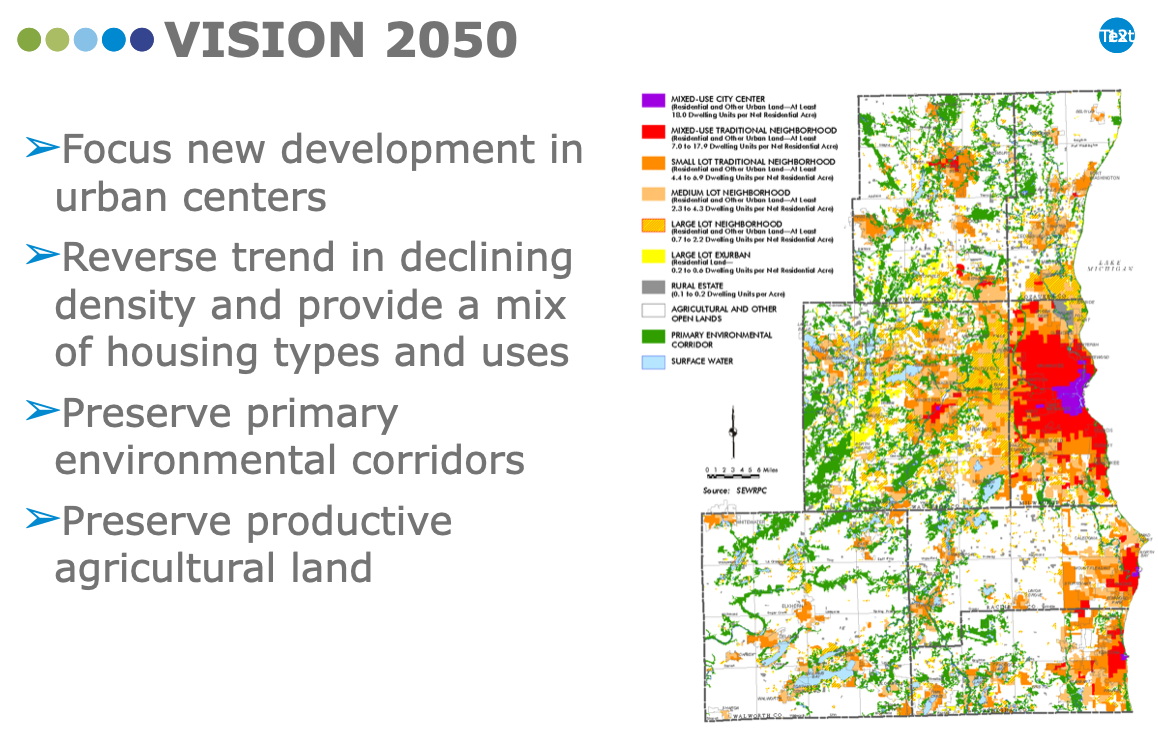
According to McKay, the SEWRPC analysis developed “about 50 recommendations,” covering a “number of topics,” such as housing “affordability, accessibility, fair housing, subsidized housing, (and) development practices.”
Key recommendations were among those he felt were “really important” for sewered communities and local plan implementation, he said, identifying them as follows:
• Sewered communities should provide areas for developing modest single family and multifamily housing.
• Sewered communities with a job-housing imbalance should review and update their comprehensive plans and zoning ordinances to provide housing affordable for the workforce of the community.
• Sewered communities should have flexible zoning regulations to encourage a variety of housing types.
• Extend Tax Incremental Financing Districts (TIDs) for one year to fund affordable housing, as permitted by state law, which, he said, was passed in 2009. He said 75% of that one-year increment can be used to fund or support affordable housing and then 25% can be used to support housing in general, in the community and not just in the district through which the funds were realized.
McKay said a report requested by the city of Whitewater in 2020, and completed in 2021 by SEWRPC, identified several ways TID extension could help implement the city’s comprehensive plan.
An earlier story about the SEWRPC housing study for Whitewater, which was revisited by the Whitewater Common Council in 2022, is here: https://fortatkinsononline.com/whitewater-council-revisits-2020-housing-study/.
He next touched upon the Vision 2050 document, which, he noted, was informed by the Regional Housing Plan.
When looking to the future, the plan advises communities to:
• Focus on new development in urban centers.
• Reverse trends in declining density and provide a mix of housing types and uses.
• Preserve primary environmental corridors.
• Preserve productive agricultural land.
Population trends
McKay concluded his presentation by sharing several graphs showing population trends.
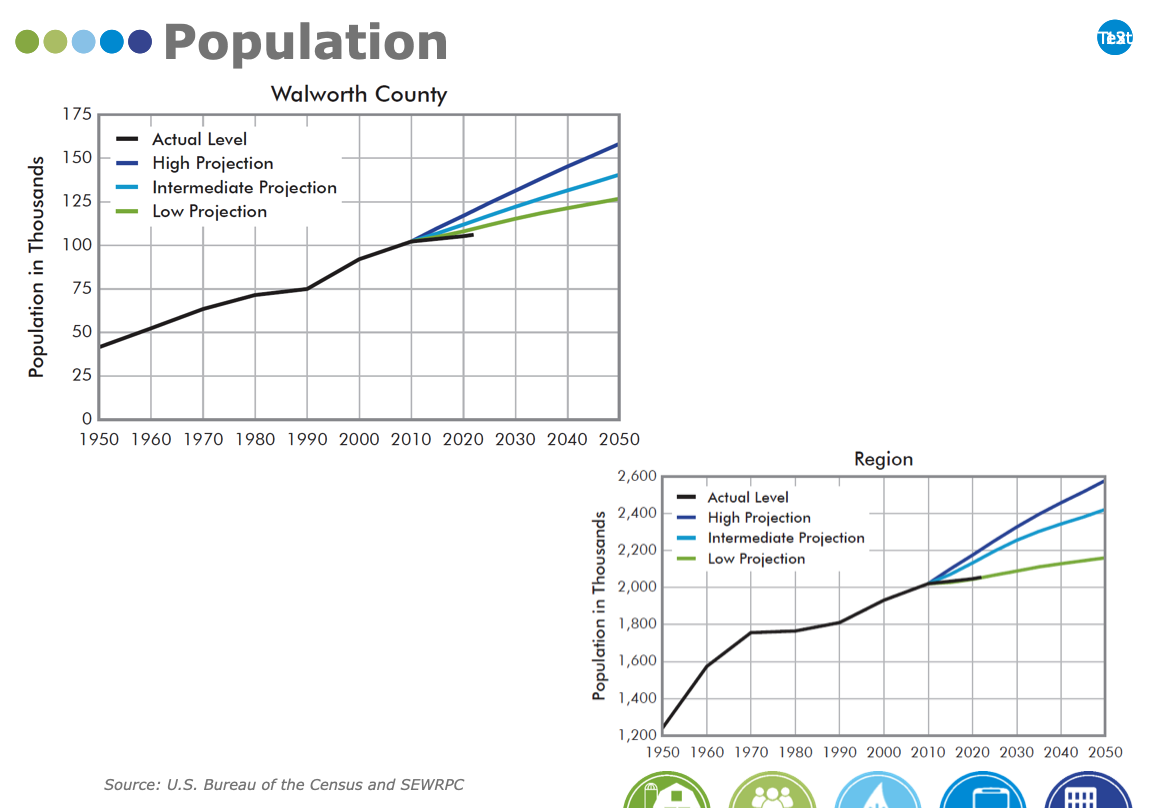
A first set of graphs, shown above, offers population predictions both regionally, across the seven county area, and in Walworth County.
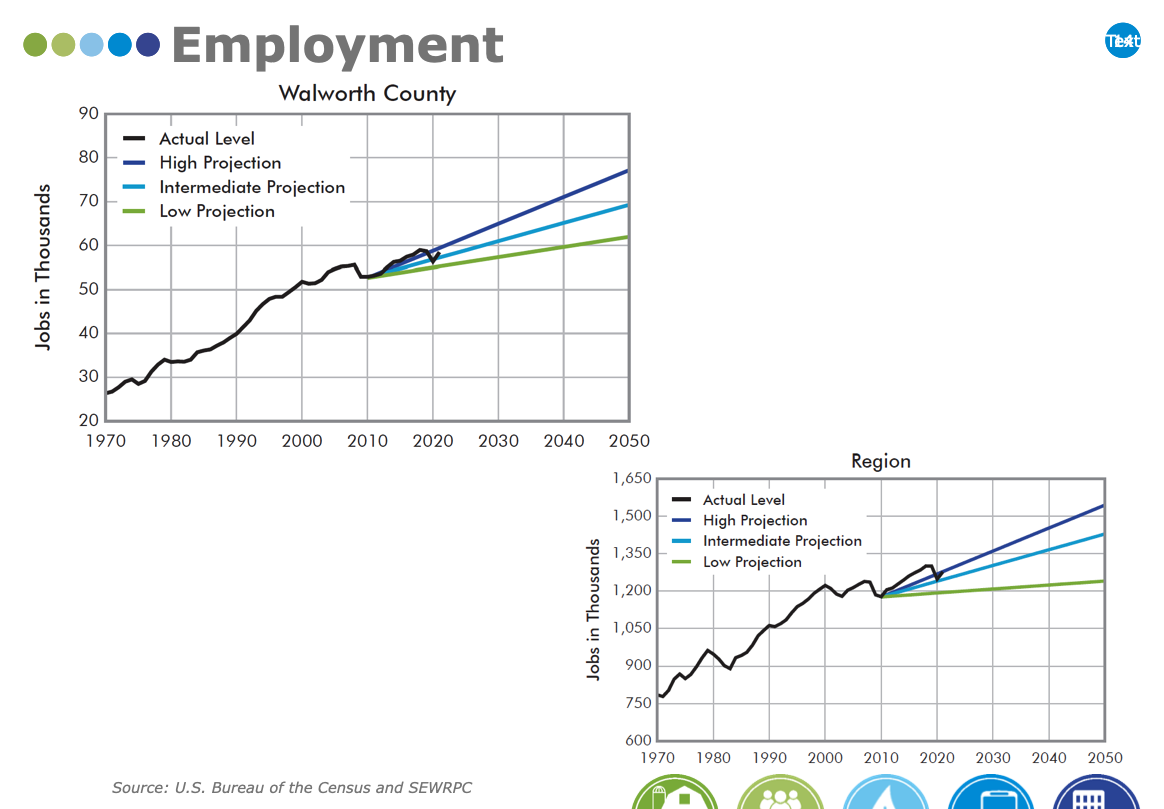
A second set of graphs, shown above, offers employment grown trends both regionally and in Walworth County.
To learn more about SEWRPC, visit its website: sewrpc.org.
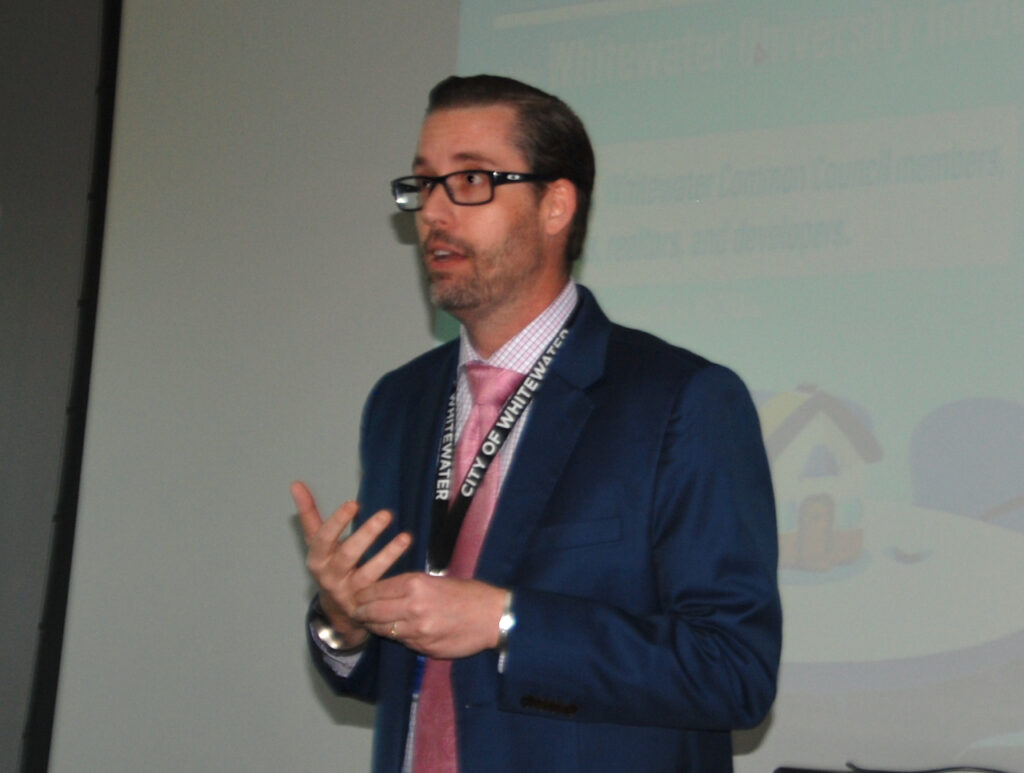
Whitewater City Manager John Weidl, addressing some 60 attendees, kicks off the Whitewater Housing Roundtable program and introduces the city’s Economic Development Director Taylor Zeinert.

Whitewater Economic Development Director Taylor Zeinert welcomes program attendees and introduces the first of two keynote speakers, Southeastern Wisconsin Regional Planning Commission Deputy Director Ben McKay. A second speaker, Erik Doersching, executive vice president and managing partner of Illinois-based Tracy Cross and Associates, Inc., a real estate marketing consulting firm, will be featured in the second part of this two-part story.
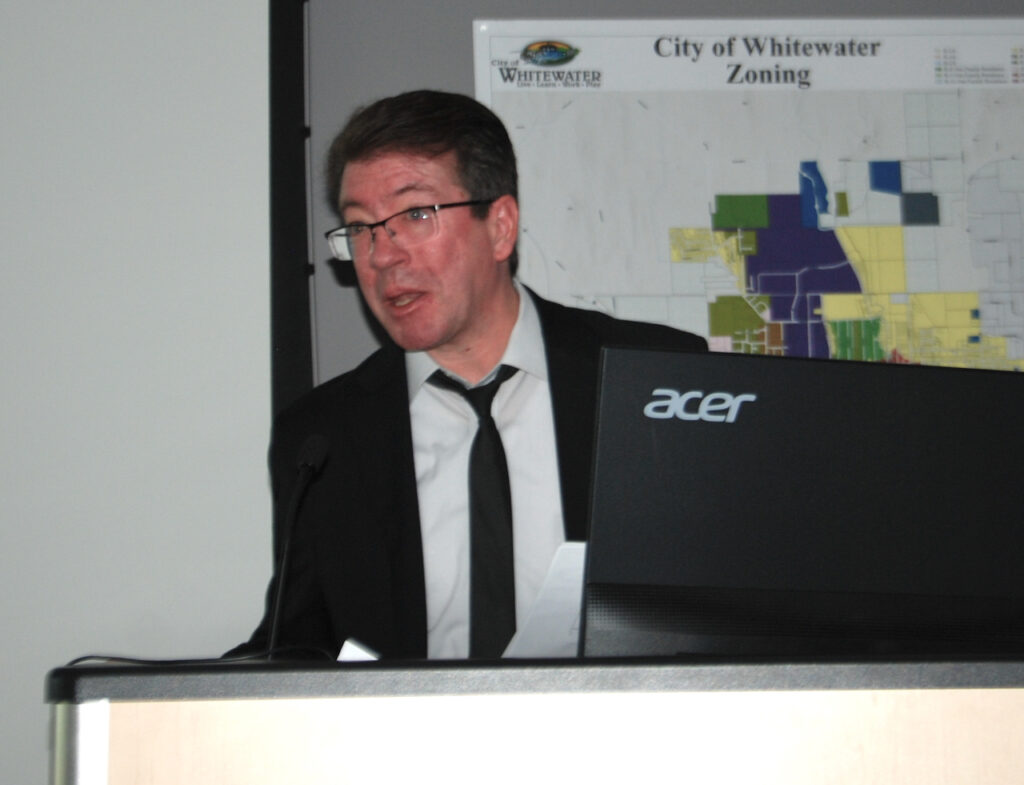
Southeastern Wisconsin Regional Planning Commission Deputy Director Ben McKay addresses some 60 participants attending a Whitewater Housing Roundtable program last Thursday. McKay shared various statistics from across a seven-county region, with some additional details focusing on Walworth County and Whitewater, as they related to housing availability, barriers to development, and jobs.
Kim McDarison photos.
This post has already been read 987 times!
Kim
Our Advertisers
Most Read Posts
- Our Take: If secrecy is embraced, transparency is disabled

- Eight finalists make the cut in Whitewater WindUp competition; winner to be chosen May 18

- DOT: Two-phased improvement project slated for highways 11 and 12 in Walworth County
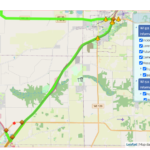
- UW-Whitewater students celebrate as weather warms up and school year winds down

- Roundtable presenter shares affordable housing designs, cost-reducing construction options

- DOT: Department revokes three Elkhorn wholesale dealers' licenses

- Commentary: Remembering journalist Sam Martino

- Storytelling, art bring event-goers to Flat Iron Park

- UW-Whitewater May 2024 graduates receive degrees

- Food drive to support local pantries to be held Saturday













